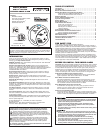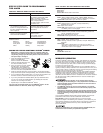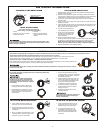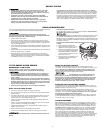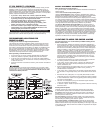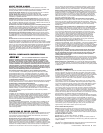
5
IF YOU SUSPECT A PROBLEM
Smoke Alarms may not operate pr
operly because of dead, missing or weak
batteries, a build-up of dirt, dust or grease on the Smoke Alarm cover, or
installation in an impr
oper location. Clean the Smoke Alarm as described in
“Regular Maintenance,” and install a fresh battery, then test the Smoke Alarm
again. If it fails to test properly when you use the test button, or if the problem
persists, r
eplace the Smoke Alarm immediately.
•
If you hear a “chirp” about once a minute, replace the battery.
• If you experience frequent non-emergency alarms (like those caused
by cooking smoke), tr
y relocating the Smoke Alarm.
•
If the alarm sounds when no smoke is visible, try cleaning or
relocating the Smoke Alarm. The cover may be dirty.
•
If the alarm does not sound during testing, try installing a new
battery, and make sure it is snapped in securely.
•
If the alarm sounds 3 rapid “chirps” every minute; LED flashes
approximately once a minute. MALFUNCTION: the device is not
working pr
operly and needs to be replaced.
If the Smoke Alarm is still not operating pr
operly, and it is still under warranty,
please see “How to Obtain Warranty Service” in the Limited Warranty.
Do not tr
y fixing the alarm yourself – this will void your warranty!
RECOMMENDED LOCATIONS FOR
SMOKE ALARMS
Installing Smoke Alarms in Single-Family Residences
The National Fir
e Protection Association (NFPA), recommends one Smoke
Alarm on every floor, in every sleeping area, and in every bedroom. In new
construction, the Smoke Alarms must be AC powered and interconnected.
See “Agency Placement Recommendations” for details. For additional cover
-
age, it is recommended that you install a Smoke Alarm in all rooms, halls,
storage areas, finished attics, and basements, where temperatures normally
r
emain between 40˚ F (4˚ C) and 100˚ F (38˚ C). Make sure no door or other
obstruction could keep smoke from reaching the Smoke Alarms.
More specifically, install Smoke Alarms:
• On every level of your home, including finished attics and basements.
• Inside every bedroom, especially if people sleep with doors closed.
• In the hall near every sleeping area. If your home has multiple sleeping
areas, install a unit in each. If a hall is over 40 feet (12 meters) long, install
an alarm at each end.
• At the top of the first-to-second floor stairway, and at bottom of basement
stairway.
Specific requirements for Smoke Alarm installation vary from state to state
and from region to region. Check with your local Fire Department for current
requirements in your area.
It is recommended AC or AC/DC units be inter-
connected for added protection.
AGENCY PLACEMENT RECOMMENDA
TIONS
NFP
A 72 (National Fire Code) Chapter 11
“For your information, the National Fir
e Protection Association's Standard 72,
r
eads as follows:
“11.5.1 One- and T
wo-Family Dwelling Units.”
“11.5.1.1 Smoke Detection.
Wher
e required by applicable laws, codes, or
standards for the specified occupancy, approved single- and multiple-station
Smoke Alarms shall be installed as follows: (1) In all sleeping r
ooms
Exception: Smoke Alarms shall not be r
equired in sleeping rooms in existing
one- and two-family dwelling units. (2) Outside of each separate sleeping area,
in immediate vicinity of the sleeping r
ooms. (3) On each level of the dwelling
unit, including basements Exception: In existing one- and two family dwelling
units, approved Smoke Alarms powered by batteries are permitted.”
“A.11.8.3 Are More Smoke Alarms Desirable? The required number of
Smoke Alarms might not pr
ovide reliable early warning protection for those
ar
eas separated by a door from the areas protected by the required Smoke
Alarms. For this reason, it is recommended that the householder consider
the use of additional Smoke Alarms for those ar
eas for increased protection.
The additional ar
eas include the basement, bedrooms, dining room, furnace
room, utility room, and hallways not protected by the required Smoke Alarms.
The installation of Smoke Alarms in kitchens, attics (finished or unfinished),
or garages is not normally recommended, as these locations occasionally
experience conditions that can result in improper operation.”
LOCATIONS TO AVOID FOR SMOKE ALARMS
For best per
formance, it is recommended you AVOID installing Smoke
Alarms in these areas:
•
Where combustion particles are produced. Combustion particles form
when something burns. Areas to avoid include poorly ventilated kitchens,
garages, and fur
nace rooms. Keep units at least 20 feet (6 meters) from
the sources of combustion particles (stove, furnace, water heater, space
heater) if possible. In areas where a 20-foot (6-meter) distance is not
possible – in modular, mobile, or smaller homes, for example – it is
r
ecommended the Smoke Alarm be placed as far from these fuel-burning
sources as possible. The placement r
ecommendations are intended to
keep these Alarms at a reasonable distance from a fuel-burning source,
and thus reduce “unwanted” alarms. Unwanted alarms can occur if a
Smoke Alarm is placed directly next to a fuel-burning source. Ventilate
these areas as much as possible.
• In air streams near kitchens. Air currents can draw cooking smoke into
the sensing chamber of a Smoke Alarm near the kitchen.
• In very damp, humid or steamy areas, or directly near bathrooms with
showers. Keep units at least 10 feet (3 meters) away from showers,
saunas, dishwashers, etc.
• Where the temperatures are regularly below 40˚ F (4˚ C) or above 100˚ F
(38˚ C), including unheated buildings, outdoor rooms, porches, or
unfinished attics or basements.
• In very dusty, dirty, or greasy areas. Do not install a Smoke Alarm directly
over the stove or range. Keep laundry room Smoke Alarms free of dust or
lint.
• Near fresh air vents, ceiling fans, or in very drafty areas. Drafts can blow
smoke away from the unit, preventing it from reaching the sensing chamber.
• In insect infested areas. Insects can clog openings to the sensing chamber
and cause unwanted alarms.
• Less than 12 inches (305mm) away from fluorescent lights. Electrical
“noise” can interfere with the sensor.
•
In “dead air” spaces. “Dead air” spaces may prevent smoke from reaching
the Smoke Alarm.
Avoiding Dead Air Spaces
“Dead air” spaces may prevent smoke from reaching the Smoke Alarm.
To avoid dead air spaces, follow the installation recommendations below.
On ceilings, install Smoke Alarms as close to the center of the ceiling as
possible. If this is not possible, install the Smoke Alarm at least 4 inches
(102 mm) from the wall or corner.
For wall mounting (if allowed by building codes), the top edge of Smoke
Alarms should be placed between 4 and 12 inches (102 and 305 mm) from
the wall/ceiling line, below typical “dead air” spaces.
On a peaked, gabled, or cathedral ceiling, install the first Smoke Alarm
within 3 feet (0.9 meters) of the peak of the ceiling, measured horizontally.
Additional Smoke Alarms may be required depending on the length, angle, etc.
of the ceiling's slope. Refer to NFPA 72 for details on requirements for sloped
or peaked ceilings.



